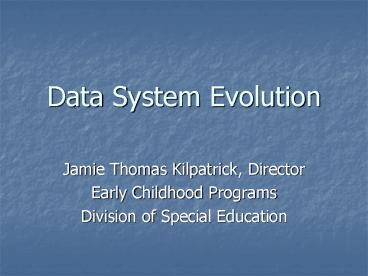Data System Evolution - PowerPoint PPT Presentation
1 / 11
Title:
Data System Evolution
Description:
Old Quantitative Database (QD) was developed to collect early ... Local decision on data entry & interpretation. Difficulty in making statewide compilations ... – PowerPoint PPT presentation
Number of Views:16
Avg rating:3.0/5.0
Title: Data System Evolution
1
Data System Evolution
- Jamie Thomas Kilpatrick, Director
- Early Childhood Programs
- Division of Special Education
2
istory
- Old Quantitative Database (QD) was developed to
collect early intervention data circa 1990 - QD was a File Maker Pro System that was not
consistent across all POEs - No consistent data manual
- No clear approach to system training
3
istory
- Local decision on data entry interpretation
- Difficulty in making statewide compilations
- QD served primarily as data dump
- Previous Annual Reports were primarily case
example- human interest stories
4
ennessees Early InterventionData System
- Web-Based Real time Database
- Early intervention staff and vendors have
password protected user accounts, log-in access
to the data base to their own data entry - System designed so service coordinators can
enter their own data - Canned Reports designed at State, POE and Vendor
level-related to Indicator 1 Timely Delivery of
Services
5
eporting
- TEIDS has canned reports that can be run at the
employee level, service coordinator level, child
level, agency level, therapist level - Each POE utilizes features to run their own ad
hoc reports for local decision making, e.g.
caseload distribution, therapy assignments,
referrals - TEIDS directly produces validated data reports
for local, state and federal reporting, e.g. 618
reports, SPP and APR data
6
Indicator 1
- Indicator 1-Timely Delivery of Services
- First time (Part B or C) that OSEP has ever asked
for delivered services data - Previous reporting related to services was
specifically planned service detail from the IFSP - An off-the-shelf IFSP writing tool will not
answer this indicator. Must have delivered
service detail
7
Indicator 1
- Previous to TEIDS-only way to gather this data
was traditional monitoring - Traditional monitoring meant-the car-the
hotel-bad restaurants-the files-the sample size - TEIDS ties all services to a specific IFSP
- Service Providers report all delivered services
data-regardless of payor source
8
Indicator 1
- Service Providers report all delivered services
data-regardless of payor source - Validations programmed into the system to insure
that the frequency, intensity, duration, setting,
and services must be consistent with the IFSP
9
Lessons Learned
- Do your Intra-Agency work FIRST!
- Do your Inter-Agency work related to the
delivered service data - Develop Policies Procedures-First-Then develop
your data system to enforce your policies (do not
have your data system make the policies)
10
Lessons Learned
- Data Collection Systems no longer are warehouses
for IFSPs. You need an interactive system that
includes demographic elements, fiscal components,
delivered services data, canned reports and
ad-hoc features that are customized to
accommodate your state!
11
Questions?































